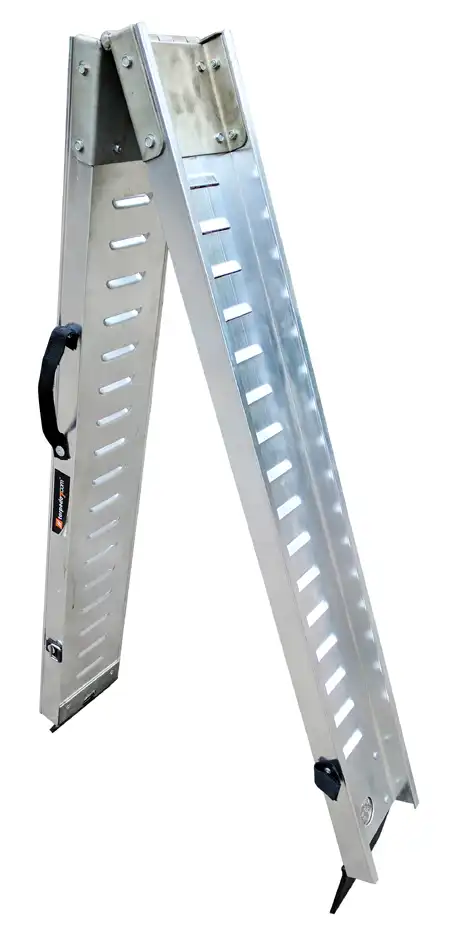The Anatomy of a Heavy-Duty Moto Ramp
Materials Matter: Aluminum vs. Steel
When it comes to heavy-duty moto ramps, the choice of materials plays a essential part in their execution and solidness. Aluminum and steel are the two essential contenders, each with its possess set of preferences. Aluminum inclines are prized for their lightweight nature, making them simple to move and transport. In spite of their featherlight feel, they gloat noteworthy strength-to-weight proportions, competent of supporting considerable loads without compromising auxiliary astuteness. The corrosion-resistant properties of aluminum too guarantee life span, indeed when uncovered to unforgiving climate conditions.
On the other hand, steel ramps are renowned for their unparalleled strength and robustness. These ramps can withstand extreme weights and are often the go-to choice for heavier motorcycles or when durability is the top priority. While steel ramps may be heavier to handle, they offer a sense of solidity that some riders find reassuring. The choice between aluminum and steel often comes down to personal preference, the specific requirements of your off-road beast, and how you plan to use the ramp.
Design Features for Maximum Safety
Safety is paramount when it comes to loading and unloading your precious off-road machine. Heavy-duty motorcycle loading ramps incorporate several design features to ensure a secure experience. Serrated crossbars or rungs provide excellent traction, preventing your motorcycle's tires from slipping, even in wet conditions. Many models also feature raised side rails, offering an extra layer of protection against accidental veering off the ramp.
Foldable designs are another crucial safety feature, allowing for compact storage and reducing the risk of accidents when the ramp is not in use. Some advanced models even incorporate adjustable support legs, providing additional stability during the loading process. These thoughtful design elements work in concert to create a safe and user-friendly loading experience, giving you peace of mind every time you transport your off-road beast.
Weight Capacity and Length Considerations
Choosing the right moto ramp involves careful consideration of both weight capacity and length. The weight capacity of a ramp should comfortably exceed the weight of your motorcycle to ensure safety and longevity. It's wise to opt for a ramp with a capacity that's at least 20% higher than your bike's weight to account for dynamic loading forces.
Length is equally crucial, as it determines the angle of incline when loading your motorcycle. A longer ramp provides a gentler slope, making it easier to walk your bike up or ride it if you're more experienced. However, longer ramps may be more challenging to store and transport. The ideal length depends on factors such as the height of your truck bed or trailer and your comfort level with steeper inclines. Many riders find that a ramp length between 7 and 9 feet offers a good balance between ease of use and practicality.
Mastering the Art of Loading Your Off-Road Beast
Preparation is Key: Setting Up Your Ramp
Before you even think about rolling your off-road beast onto the ramp, proper setup is crucial. Begin by ensuring your vehicle is parked on a flat, stable surface. Engage the parking brake and chock the wheels for added security. When positioning the moto ramp, align it squarely with your truck bed or trailer, avoiding any sideways angle that could compromise stability.
Most heavy-duty motorcycle ramps come with safety straps or hooks. These should be securely fastened to your vehicle's frame or dedicated tie-down points. This step is vital in preventing the ramp from slipping or detaching during the loading process. Take a moment to inspect the ramp's surface for any debris or damage that could affect traction. A clean, well-maintained ramp surface is essential for a safe loading experience.
Technique Matters: Walking vs. Riding
When it comes to actually getting your off-road beast up the ramp, you have two main options: walking it up or riding it. Walking your motorcycle up the ramp is generally considered the safer option, especially for beginners or those dealing with particularly heavy machines. To do this effectively, position yourself on the uphill side of the bike, using your body as a counterbalance. Maintain a firm grip on the handlebars and use the bike's power to assist you, gently applying throttle as needed.
For more experienced riders, riding the motorcycle up the ramp can be quicker and, in some cases, safer as it allows for better control. If you choose this method, approach the ramp straight on and maintain a steady, controlled speed. Avoid sudden acceleration or braking, which can destabilize the bike. Keep your body centered and slightly forward to maintain balance. Regardless of the method you choose, always wear appropriate safety gear, including sturdy boots with good grip.
Securing Your Motorcycle for Transport
Once your off-road beast is safely loaded, the job isn't quite finished. Proper securing is essential to ensure your motorcycle remains stable during transport. Start by lowering the bike onto its kickstand or a wheel chock, depending on your setup. Use high-quality tie-down straps, attaching them to solid points on your motorcycle such as the frame or triple clamps. Avoid using plastic parts or areas that could bend under pressure.
The goal is to compress the suspension slightly, creating a firm but not overly tight hold. Cross-strap for added stability, creating an X pattern that prevents side-to-side movement. If you're transporting long distances or over rough terrain, consider using additional straps or a dedicated motorcycle transport system for extra security. Remember to check the tension of your straps periodically during your journey, as they may loosen due to vibration or temperature changes.
Maintaining and Upgrading Your Moto Ramp
Regular Maintenance for Longevity
Like any piece of equipment, your heavy-duty moto ramp and motorcycle ramp require regular maintenance to ensure its longevity and optimal performance. Start with a thorough inspection before and after each use. Look for any signs of wear, such as bent rungs, loose rivets, or damaged welds. Pay special attention to the hinges on folding ramps, as these can be prone to wear over time.
Keep your ramp clean by wiping it down after use, especially if you've been in muddy or dusty conditions. For aluminum ramps, a mild soap and water solution is usually sufficient. Steel ramps may benefit from a light coating of rust-inhibiting oil, particularly if stored in humid environments. If your ramp has moving parts, such as folding mechanisms or adjustable legs, lubricate these periodically to ensure smooth operation. By implementing a regular maintenance routine, you can significantly extend the life of your moto ramp and ensure it's always ready for your next off-road adventure.
Upgrades and Accessories to Enhance Performance
While a basic heavy-duty moto ramp is often sufficient for most needs, there are several upgrades and accessories that can enhance its performance and versatility. Traction mats or grip tape can be applied to the ramp surface for additional grip, especially useful in wet conditions. Some riders opt for modular ramp systems that allow for customizable lengths and configurations, adapting to different vehicles or loading situations.
For those frequently loading in low-light conditions, LED light strips can be a game-changer, illuminating the ramp surface for safer nighttime loading. Ramp extensions or toppers can provide a gentler transition from the ramp to your truck bed or trailer, reducing the risk of bottoming out. If you're dealing with particularly heavy motorcycles, hydraulic or electric assist systems can make the loading process significantly easier. These upgrades not only improve the functionality of your moto ramp but can also enhance safety and convenience in your off-road transport setup.
When to Replace Your Moto Ramp
Even with diligent maintenance, there will come a time when your heavy-duty moto ramp needs to be replaced. Knowing when to make this decision is crucial for your safety and the security of your off-road beast. Look for signs of significant structural wear, such as deep scratches, cracks, or bends in the main body of the ramp. If you notice any welds starting to separate or excessive play in folding mechanisms, these are red flags that should not be ignored.
Consider the age and usage history of your ramp. If you've been using it frequently for several years, especially in harsh conditions, it may be nearing the end of its safe lifespan. Changes in your needs, such as acquiring a heavier motorcycle or a different transport vehicle, might also necessitate an upgrade to a more suitable ramp. When in doubt, consult with a professional or the manufacturer. Remember, the cost of a new ramp is insignificant compared to the potential cost of a failed loading attempt or damaged motorcycle. Prioritize safety and don't hesitate to replace your moto ramp when the time comes.
Conclusion
The heavy-duty moto ramp is an irreplaceable device for any genuine off-road devotee. It's not fair around getting your cruiser from point A to point B; it's around doing so securely, proficiently, and with peace of intellect. By understanding the complexities of moto ramp plan, acing legitimate stacking methods, and keeping up your gear, you guarantee that your off-road undertakings begin and conclusion on a tall note. Keep in mind, the right slope is an speculation in your energy for off-road riding. Select shrewdly, utilize it appropriately, and it will serve you well for a long time to come, encouraging incalculable exciting ventures with your off-road mammoth.
Contact Us
Ready to elevate your off-road transport game? For expert advice on choosing the perfect heavy-duty moto ramp for your needs, or to explore our range of high-quality motorcycle accessories, don't hesitate to reach out. Contact us at info@runva.com.cn and let's gear up for your next off-road adventure together!

_1737625693698.webp)


